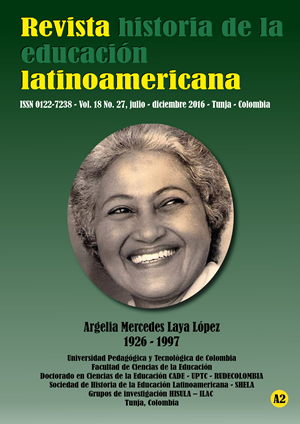Nelda Graciela Arzú Ramírez (1964…) A garifuna teacher identified with her people and her culture

Abstract
This paper presents the fruitful professional life of a teacher identified with the history and culture of her people, she constantly makes efforts for their promotion and development by overcoming difficulties and establishing bonds between her teaching performance and the comunity. Nelda’s efforts to get a degree, led her to choose the teaching career among the few options existing in her municipality. She decided to become a teacher by vocation, to serve her culture, which gave her the concepts and frames of reference for the interpretation of her world: the Garifuna culture. The work emerged in the frame of the research project entitled African and African Descendant Teachers in Colombia, Brazil, Guatemala, Venezuela, Equatorial Guinea in the century XX-XXI, within a research line on Latin American Educators. Life history method and qualitative approach were applied. Several interviews were conducted with Nelda, with people who know her and some relatives. Field visits were carried out, and impressions on her performance were released by people who have known her. As a member of the Garifuna people, the teacher Nelda has had an outstanding projection. She influences from her teacher position and her worldview, on the cultural, political and social life of the community by promoting a more accurate education regarding the linguistic and cultural reality of her people. Her teaching practices include curriculum construction, production of texts in Spanish and Garifuna language, she also boosts teachers training in bilingualism and multiculturalism for their professional practice.
Keywords
Journal History of Latin American Education; Garifuna teacher; teacher committed to her people; ONEGUA; Garifuna People; African Descent
Author Biography
Oscar Hugo López Rivas
Doctor en Educación, Ministro de Educación de Guatemala, Profesor Titular IX Universidad de San Carlos de Guatemala –USAC , Director de la Unidad de Investigación Educativa de la Escuela de Formación de Profesores de Enseñanza Media EFPEM- de la Universidad de San Carlos de Guatemala –USAC, integrante del grupo de investigación HISULA.
Humberto Rodríguez
Profesor de la Escuela de Formación de Profesores de Enseñanza Media de la Universidad de San Carlos de Guatemala, Magíster en Educación Bilingüe Intercultural, equipo de investigadores de EFPEM/USAC.
References
- Almaguer Salazar, Teresa E. El Desarrollo del alumno, Características y estilos de aprendizaje. México, Trillas, 2002.
- Arriola, Jorge L. El libro de las geonimias de Guatemala –Diccionario etimológico. Guatemala, seminario de Integración social guatemalteca/Editorial José de Pineda Ibarra, 1973.
- Centeno García, Santos. Historia del Movimiento Negro Hondureño. Tegucigalpa: Editorial Guaymuras, 1997.
- En Caribe, Enciclopedia de historia y cultura del Caribe. Salvador Suazo Bernárdez. http://www.encaribe.org/es/article/salvador-suazo-bernardez/1079, recuperado 28 de septiembre, 2014.
- Gargallo, Francesca. El pueblo garífuna: Caribes y cimarrones hoy. En Cuadernos Pedagógicos No. 18, Guatemala, Ministerio de Educación: Editorial Óscar de León Palacios, 2002.
- González Orellana, Carlos. Historia de la Educación en Guatemala. VI Edición. Guatemala: Editorial Universitaria, Universidad de San Carlos de Guatemala, 2007.
- Menéndez, Luis Antonio. La Educación en Guatemala 1954 – 2004, Enfoque Histórico Estadístico. Guatemala: Editorial Universitaria de la USAC, 2006.
- Meylan Díaz, Manuel Humberto. Estudio Fenomenológico de la Cultura Garífuna en Guatemala; desde la Empatía. Tesina en, Universidad Rafael Landívar, Facultad de Filosofía, 2004.
- Ministerio de Educación, Recopilación de Leyes de Educación Bilingüe Intercultural. Guatemala: Editorial Nojib’sa, 2005.
- Presidencia de la República de Guatemala. Los Acuerdos de Paz. Guatemala, 1997.
- Rodríguez Rouanet, Francisco. Diccionario Municipal de Guatemala. Guatemala: Fondo de Cultura Editorial, 1996.
- Suazo B y E. Salvador. La Escritura Garífuna. Abürühani lau Garifuna". Tegucigalpa, Litografìa López, S. de R.L., 2000.
- Us Soc, Pedro. ¿Hacia dónde va la Educación Bilingüe Intercultural, EBI, o Intercultural Bilingüe, EIB, en Mesoamérica? Guatemala: Editorial Cholsamaj, 2014.
